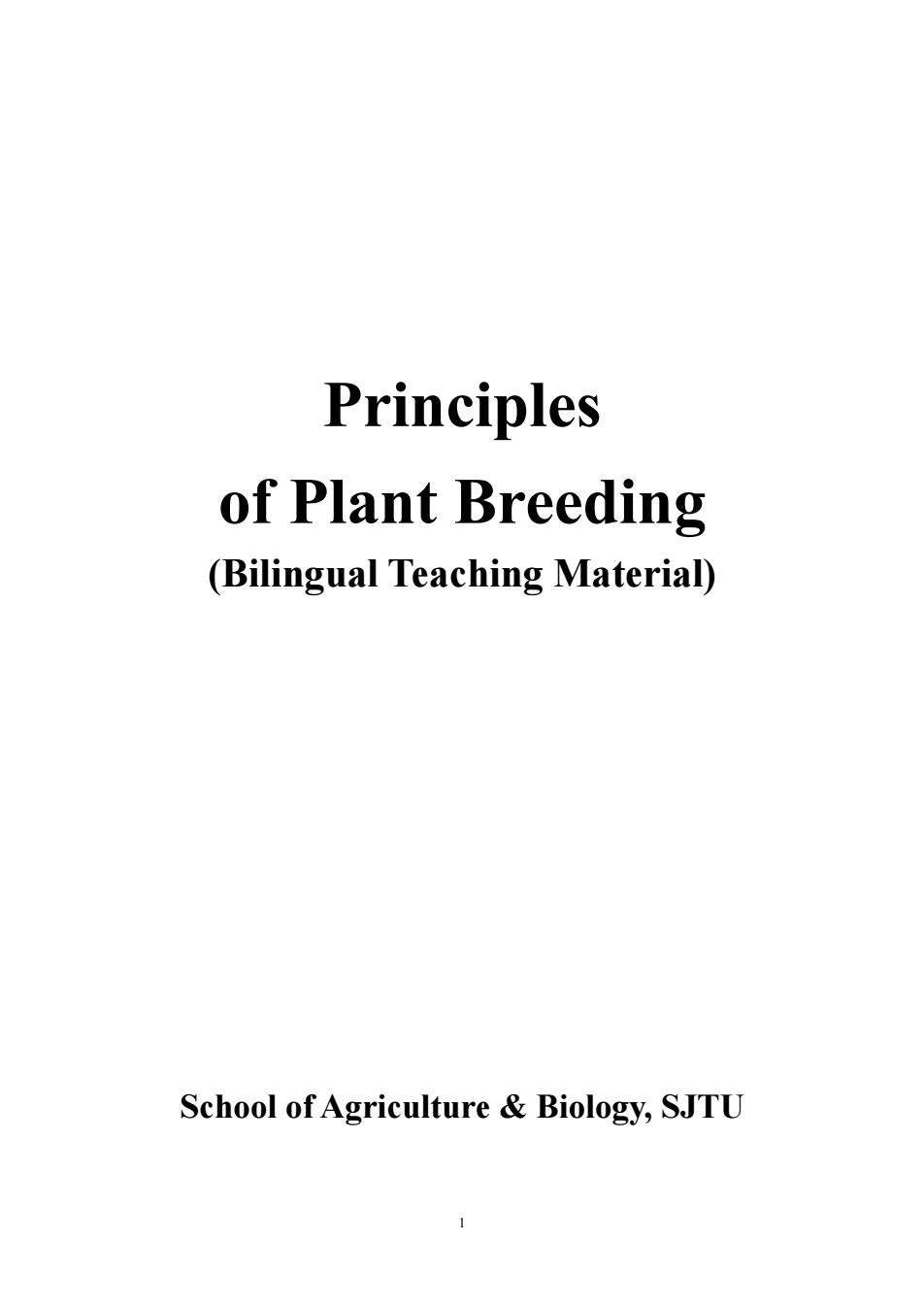
Principles of Plant Breeding (Bilingual Teaching Material) School of Agriculture Biology,SJTU
1 Principles of Plant Breeding (Bilingual Teaching Material) School of Agriculture & Biology, SJTU
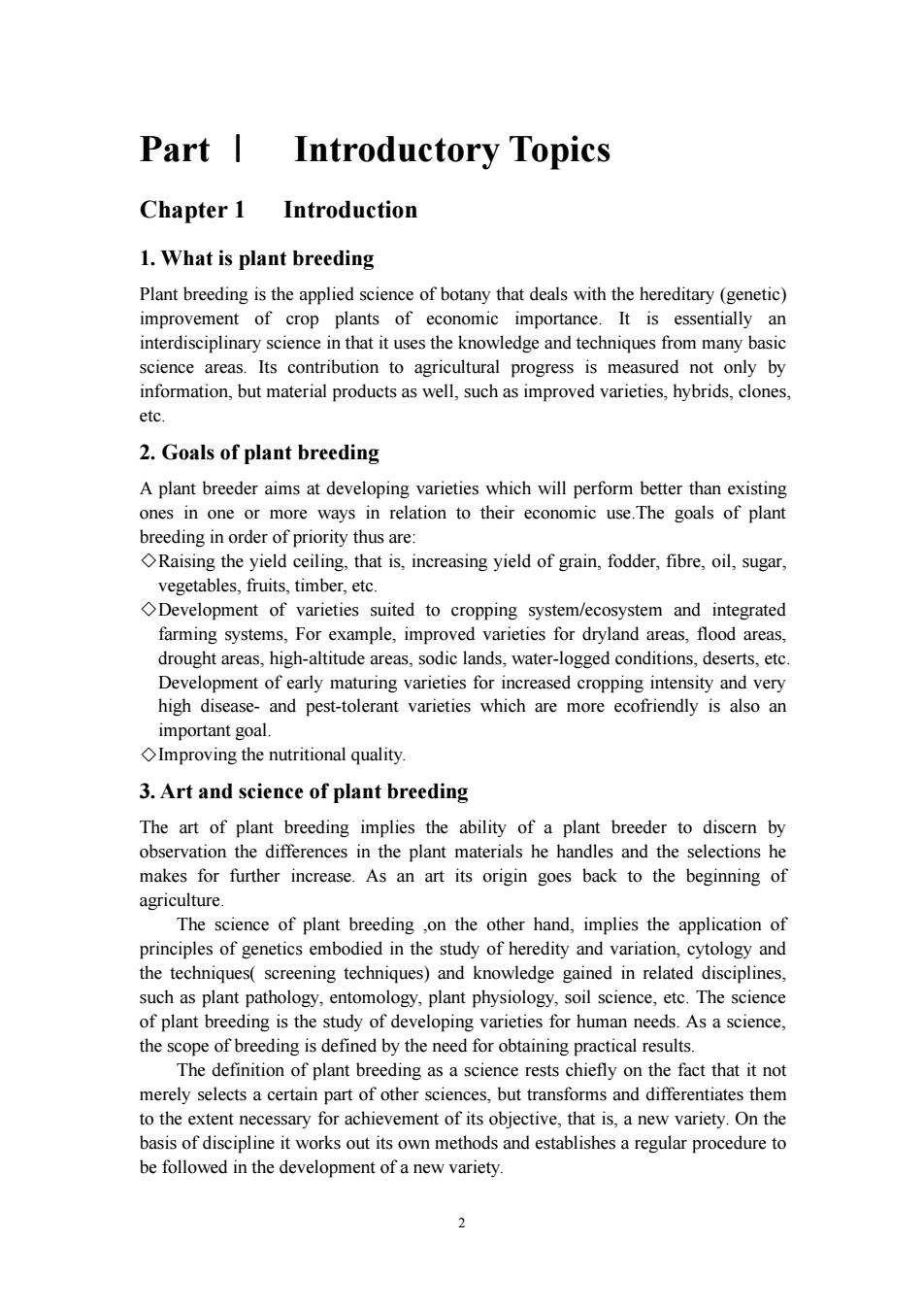
Part Introductory Topics Chapter 1 Introduction 1.What is plant breeding Plant breeding is the applied science of botany that deals with the hereditary(genetic) improvement of crop plants of economic importance.It is essentially an interdisciplinary science in that it uses the knowledge and techniques from many basic science areas.Its contribution to agricultural progress is measured not only by information,but material products as well,such as improved varieties,hybrids,clones, etc. 2.Goals of plant breeding A plant breeder aims at developing varieties which will perform better than existing ones in one or more ways in relation to their economic use.The goals of plant breeding in order of priority thus are: Raising the yield ceiling,that is,increasing yield of grain,fodder,fibre,oil,sugar, vegetables,fruits,timber,etc. Development of varieties suited to cropping system/ecosystem and integrated farming systems,For example,improved varieties for dryland areas,flood areas, drought areas,high-altitude areas,sodic lands,water-logged conditions,deserts,etc Development of early maturing varieties for increased cropping intensity and very high disease-and pest-tolerant varieties which are more ecofriendly is also an important goal. Improving the nutritional quality. 3.Art and science of plant breeding The art of plant breeding implies the ability of a plant breeder to discern by observation the differences in the plant materials he handles and the selections he makes for further increase.As an art its origin goes back to the beginning of agriculture. The science of plant breeding,on the other hand,implies the application of principles of genetics embodied in the study of heredity and variation,cytology and the techniques(screening techniques)and knowledge gained in related disciplines, such as plant pathology,entomology,plant physiology,soil science,etc.The science of plant breeding is the study of developing varieties for human needs.As a science, the scope of breeding is defined by the need for obtaining practical results. The definition of plant breeding as a science rests chiefly on the fact that it not merely selects a certain part of other sciences,but transforms and differentiates them to the extent necessary for achievement of its objective,that is,a new variety.On the basis of discipline it works out its own methods and establishes a regular procedure to be followed in the development of a new variety. 2
2 Part Ⅰ Introductory Topics Chapter 1 Introduction 1. What is plant breeding Plant breeding is the applied science of botany that deals with the hereditary (genetic) improvement of crop plants of economic importance. It is essentially an interdisciplinary science in that it uses the knowledge and techniques from many basic science areas. Its contribution to agricultural progress is measured not only by information, but material products as well, such as improved varieties, hybrids, clones, etc. 2. Goals of plant breeding A plant breeder aims at developing varieties which will perform better than existing ones in one or more ways in relation to their economic use.The goals of plant breeding in order of priority thus are: ◇Raising the yield ceiling, that is, increasing yield of grain, fodder, fibre, oil, sugar, vegetables, fruits, timber, etc. ◇Development of varieties suited to cropping system/ecosystem and integrated farming systems, For example, improved varieties for dryland areas, flood areas, drought areas, high-altitude areas, sodic lands, water-logged conditions, deserts, etc. Development of early maturing varieties for increased cropping intensity and very high disease- and pest-tolerant varieties which are more ecofriendly is also an important goal. ◇Improving the nutritional quality. 3. Art and science of plant breeding The art of plant breeding implies the ability of a plant breeder to discern by observation the differences in the plant materials he handles and the selections he makes for further increase. As an art its origin goes back to the beginning of agriculture. The science of plant breeding ,on the other hand, implies the application of principles of genetics embodied in the study of heredity and variation, cytology and the techniques( screening techniques) and knowledge gained in related disciplines, such as plant pathology, entomology, plant physiology, soil science, etc. The science of plant breeding is the study of developing varieties for human needs. As a science, the scope of breeding is defined by the need for obtaining practical results. The definition of plant breeding as a science rests chiefly on the fact that it not merely selects a certain part of other sciences, but transforms and differentiates them to the extent necessary for achievement of its objective, that is, a new variety. On the basis of discipline it works out its own methods and establishes a regular procedure to be followed in the development of a new variety

4.Contribution of plant breeding Most of the cultivated species of crop plants have been modified by plant breeding to increase their usefulness as food ,feed,and industrial products.Older varieties are replaced by newer combinations on continued basis.The net result is the development of higher yielding types better adapted to the environment of the area of their culture. The improvements effected by the plant breeder are gradual and progressive in that any single new variety represents but a small advance over its predecessor. Improved crop varieties give the grower an opportunity for greater profits and consequently lead to innovation and the adoption of new agricultural technology. Sometimes the advance is spectacular and can transform the importance of a crop in an area.Plant breeding thus has contributed immensely towards greater food security, productivity and improved quality of the economic product.The major achievement has been in developing varieties resistant to various diseases,insects and abiotic stresses. 5.Plant Breeding in the Twenty-First Century Plant breeding is as old as domesticated plants.When our forebears nurtured and selected desirable plants from a few favored wild species and eventually formed the first landraces,they practiced crop breeding identical in its fundamentals to today's "scientific"crop breeding.During the past 10,000years,farmer-breeders have developed untold numbers of landraces(farmer varieties),and thousands of them are still on hand,although the numbers are shrinking rapidly as professionally bred varieties answering the demands of the marketplace replace the landraces in many parts of the world. Our only record of changes in plant breeding procedures during the past 10,000years has occurred during the past couple of centuries.We imagine,without evidence,that chance outcrossing provided heterozygous new materials from which new varieties could be selected.But we do know that discovery of the nature of sexuality in plants in the eighteenth century fostered deliberate outcrossing as a basis for new variety formation.And we know that rediscovery of Mendel's principles of genetics at the end of the nineteenth century gave great impetus to development of plant breeding as a science,eventually providing full-time work to professional plant breeders. Other discoveries,inventions,and technological advances also increased the power and speed of plant breeding.Statistical theory helped breeders create efficient field plot designs and methods for precise data analysis,thereby greatly improving the accuracy of selection procedures.Statistical theory,including quantitative genetics, also provided great assistance in the design of breeding programs,giving them better precision,speed,and direction.Mechanization of planting and harvesting machinery greatly increased the quantity of yield trial data that a breeder could generate.Even though the odds for success might not be increased,breeders operated on a numerical base that was many times greater than when all trials were conducted by hand
3 4. Contribution of plant breeding Most of the cultivated species of crop plants have been modified by plant breeding to increase their usefulness as food ,feed, and industrial products. Older varieties are replaced by newer combinations on continued basis. The net result is the development of higher yielding types better adapted to the environment of the area of their culture. The improvements effected by the plant breeder are gradual and progressive in that any single new variety represents but a small advance over its predecessor. Improved crop varieties give the grower an opportunity for greater profits and consequently lead to innovation and the adoption of new agricultural technology. Sometimes the advance is spectacular and can transform the importance of a crop in an area. Plant breeding thus has contributed immensely towards greater food security, productivity and improved quality of the economic product. The major achievement has been in developing varieties resistant to various diseases, insects and abiotic stresses. 5. Plant Breeding in the Twenty-First Century Plant breeding is as old as domesticated plants. When our forebears nurtured and selected desirable plants from a few favored wild species and eventually formed the first landraces, they practiced crop breeding identical in its fundamentals to today’s “scientific” crop breeding. During the past 10,000years, farmer-breeders have developed untold numbers of landraces (farmer varieties), and thousands of them are still on hand, although the numbers are shrinking rapidly as professionally bred varieties answering the demands of the marketplace replace the landraces in many parts of the world. Our only record of changes in plant breeding procedures during the past 10,000years has occurred during the past couple of centuries. We imagine, without evidence, that chance outcrossing provided heterozygous new materials from which new varieties could be selected. But we do know that discovery of the nature of sexuality in plants in the eighteenth century fostered deliberate outcrossing as a basis for new variety formation. And we know that rediscovery of Mendel’s principles of genetics at the end of the nineteenth century gave great impetus to development of plant breeding as a science, eventually providing full-time work to professional plant breeders. Other discoveries, inventions, and technological advances also increased the power and speed of plant breeding. Statistical theory helped breeders create efficient field plot designs and methods for precise data analysis, thereby greatly improving the accuracy of selection procedures. Statistical theory, including quantitative genetics, also provided great assistance in the design of breeding programs, giving them better precision, speed, and direction. Mechanization of planting and harvesting machinery greatly increased the quantity of yield trial data that a breeder could generate. Even though the odds for success might not be increased, breeders operated on a numerical base that was many times greater than when all trials were conducted by hand
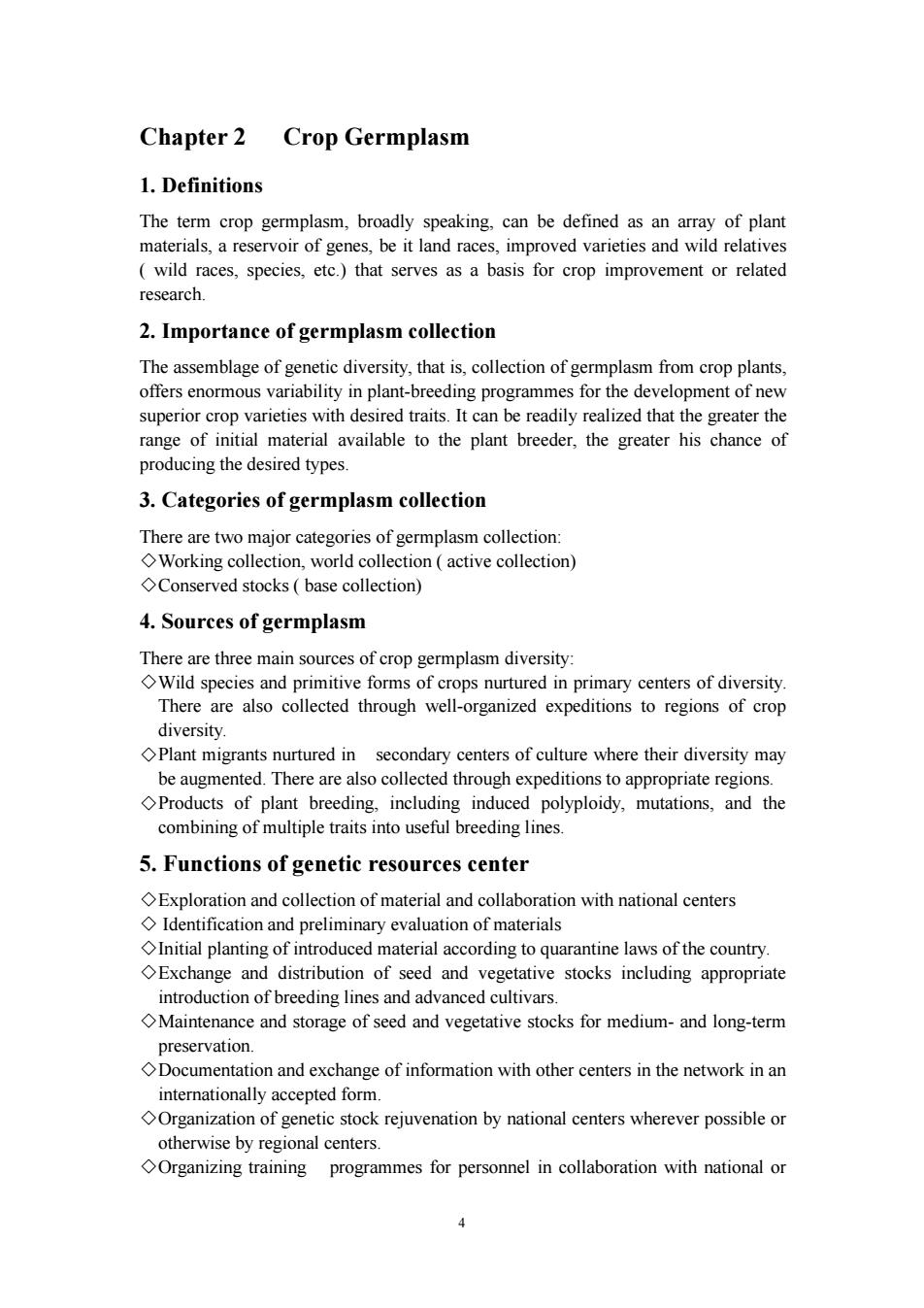
Chapter 2 Crop Germplasm 1.Definitions The term crop germplasm,broadly speaking,can be defined as an array of plant materials,a reservoir of genes,be it land races,improved varieties and wild relatives (wild races,species,ete.)that serves as a basis for crop improvement or related research. 2.Importance of germplasm collection The assemblage of genetic diversity,that is,collection of germplasm from crop plants, offers enormous variability in plant-breeding programmes for the development of new superior crop varieties with desired traits.It can be readily realized that the greater the range of initial material available to the plant breeder,the greater his chance of producing the desired types. 3.Categories of germplasm collection There are two major categories of germplasm collection: Working collection,world collection active collection) Conserved stocks base collection) 4.Sources of germplasm There are three main sources of crop germplasm diversity: Wild species and primitive forms of crops nurtured in primary centers of diversity. There are also collected through well-organized expeditions to regions of crop diversity. Plant migrants nurtured in secondary centers of culture where their diversity may be augmented.There are also collected through expeditions to appropriate regions. Products of plant breeding,including induced polyploidy,mutations,and the combining of multiple traits into useful breeding lines. 5.Functions of genetic resources center Exploration and collection of material and collaboration with national centers Identification and preliminary evaluation of materials Initial planting of introduced material according to quarantine laws of the country. Exchange and distribution of seed and vegetative stocks including appropriate introduction of breeding lines and advanced cultivars. Maintenance and storage of seed and vegetative stocks for medium-and long-term preservation. Documentation and exchange of information with other centers in the network in an internationally accepted form. Organization of genetic stock rejuvenation by national centers wherever possible or otherwise by regional centers. Organizing training programmes for personnel in collaboration with national or
4 Chapter 2 Crop Germplasm 1. Definitions The term crop germplasm, broadly speaking, can be defined as an array of plant materials, a reservoir of genes, be it land races, improved varieties and wild relatives ( wild races, species, etc.) that serves as a basis for crop improvement or related research. 2. Importance of germplasm collection The assemblage of genetic diversity, that is, collection of germplasm from crop plants, offers enormous variability in plant-breeding programmes for the development of new superior crop varieties with desired traits. It can be readily realized that the greater the range of initial material available to the plant breeder, the greater his chance of producing the desired types. 3. Categories of germplasm collection There are two major categories of germplasm collection: ◇Working collection, world collection ( active collection) ◇Conserved stocks ( base collection) 4. Sources of germplasm There are three main sources of crop germplasm diversity: ◇Wild species and primitive forms of crops nurtured in primary centers of diversity. There are also collected through well-organized expeditions to regions of crop diversity. ◇Plant migrants nurtured in secondary centers of culture where their diversity may be augmented. There are also collected through expeditions to appropriate regions. ◇Products of plant breeding, including induced polyploidy, mutations, and the combining of multiple traits into useful breeding lines. 5. Functions of genetic resources center ◇Exploration and collection of material and collaboration with national centers ◇ Identification and preliminary evaluation of materials ◇Initial planting of introduced material according to quarantine laws of the country. ◇Exchange and distribution of seed and vegetative stocks including appropriate introduction of breeding lines and advanced cultivars. ◇Maintenance and storage of seed and vegetative stocks for medium- and long-term preservation. ◇Documentation and exchange of information with other centers in the network in an internationally accepted form. ◇Organization of genetic stock rejuvenation by national centers wherever possible or otherwise by regional centers. ◇Organizing training programmes for personnel in collaboration with national or
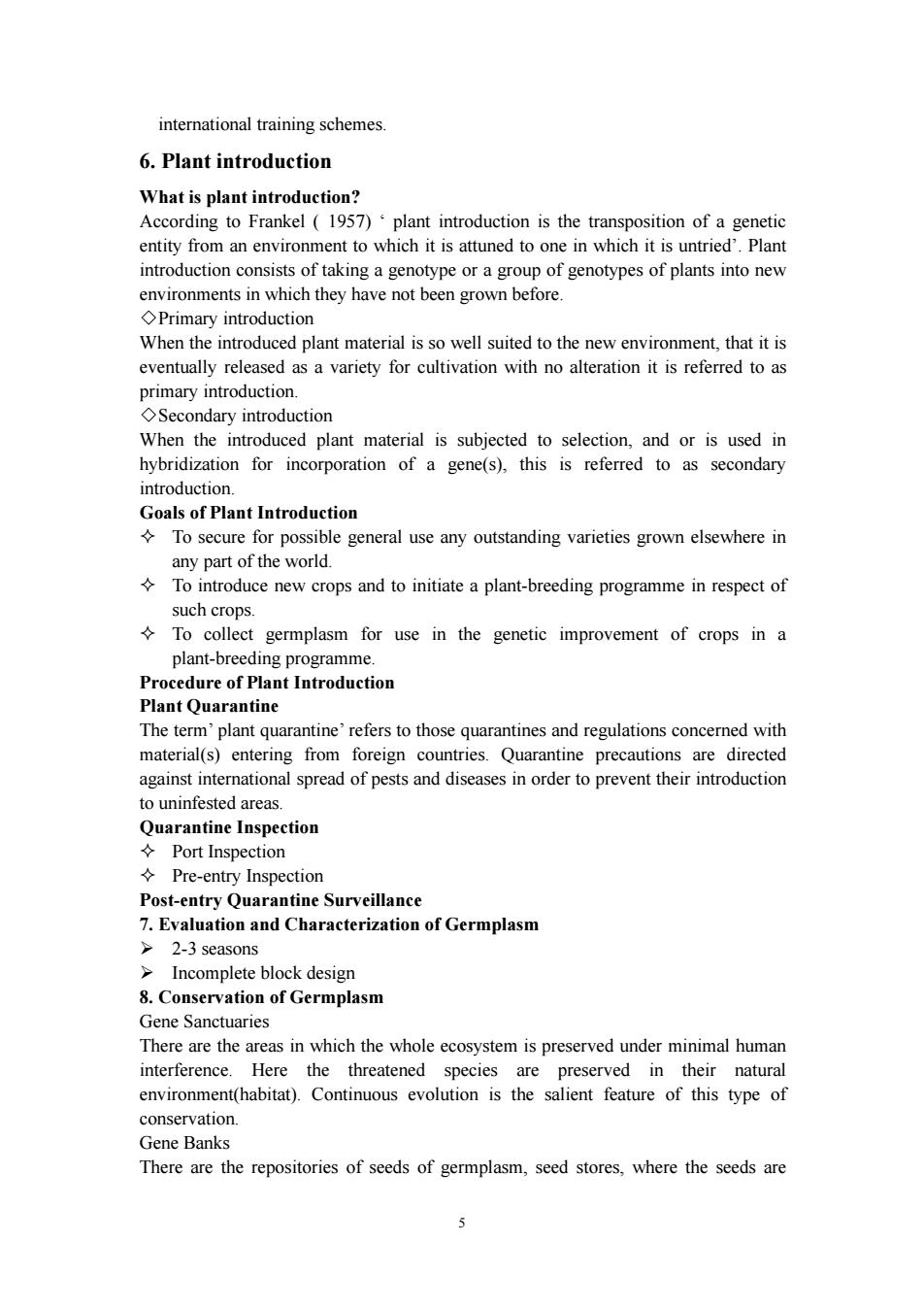
international training schemes. 6.Plant introduction What is plant introduction? According to Frankel 1957)plant introduction is the transposition of a genetic entity from an environment to which it is attuned to one in which it is untried'.Plant introduction consists of taking a genotype or a group of genotypes of plants into new environments in which they have not been grown before. Primary introduction When the introduced plant material is so well suited to the new environment,that it is eventually released as a variety for cultivation with no alteration it is referred to as primary introduction. Secondary introduction When the introduced plant material is subjected to selection,and or is used in hybridization for incorporation of a gene(s),this is referred to as secondary introduction. Goals of Plant Introduction To secure for possible general use any outstanding varieties grown elsewhere in any part of the world. To introduce new crops and to initiate a plant-breeding programme in respect of such crops. To collect germplasm for use in the genetic improvement of crops in a plant-breeding programme. Procedure of Plant Introduction Plant Quarantine The term'plant quarantine'refers to those quarantines and regulations concerned with material(s)entering from foreign countries.Quarantine precautions are directed against international spread of pests and diseases in order to prevent their introduction to uninfested areas. Quarantine Inspection ◇Port Inspection ◇Pre-entry Inspection Post-entry Quarantine Surveillance 7.Evaluation and Characterization of Germplasm >2-3 seasons >Incomplete block design 8.Conservation of Germplasm Gene Sanctuaries There are the areas in which the whole ecosystem is preserved under minimal human interference.Here the threatened species are preserved in their natural environment(habitat).Continuous evolution is the salient feature of this type of conservation Gene Banks There are the repositories of seeds of germplasm,seed stores,where the seeds are
5 international training schemes. 6. Plant introduction What is plant introduction? According to Frankel ( 1957) ‘ plant introduction is the transposition of a genetic entity from an environment to which it is attuned to one in which it is untried’. Plant introduction consists of taking a genotype or a group of genotypes of plants into new environments in which they have not been grown before. ◇Primary introduction When the introduced plant material is so well suited to the new environment, that it is eventually released as a variety for cultivation with no alteration it is referred to as primary introduction. ◇Secondary introduction When the introduced plant material is subjected to selection, and or is used in hybridization for incorporation of a gene(s), this is referred to as secondary introduction. Goals of Plant Introduction To secure for possible general use any outstanding varieties grown elsewhere in any part of the world. To introduce new crops and to initiate a plant-breeding programme in respect of such crops. To collect germplasm for use in the genetic improvement of crops in a plant-breeding programme. Procedure of Plant Introduction Plant Quarantine The term’ plant quarantine’ refers to those quarantines and regulations concerned with material(s) entering from foreign countries. Quarantine precautions are directed against international spread of pests and diseases in order to prevent their introduction to uninfested areas. Quarantine Inspection Port Inspection Pre-entry Inspection Post-entry Quarantine Surveillance 7. Evaluation and Characterization of Germplasm 2-3 seasons Incomplete block design 8. Conservation of Germplasm Gene Sanctuaries There are the areas in which the whole ecosystem is preserved under minimal human interference. Here the threatened species are preserved in their natural environment(habitat). Continuous evolution is the salient feature of this type of conservation. Gene Banks There are the repositories of seeds of germplasm, seed stores, where the seeds are
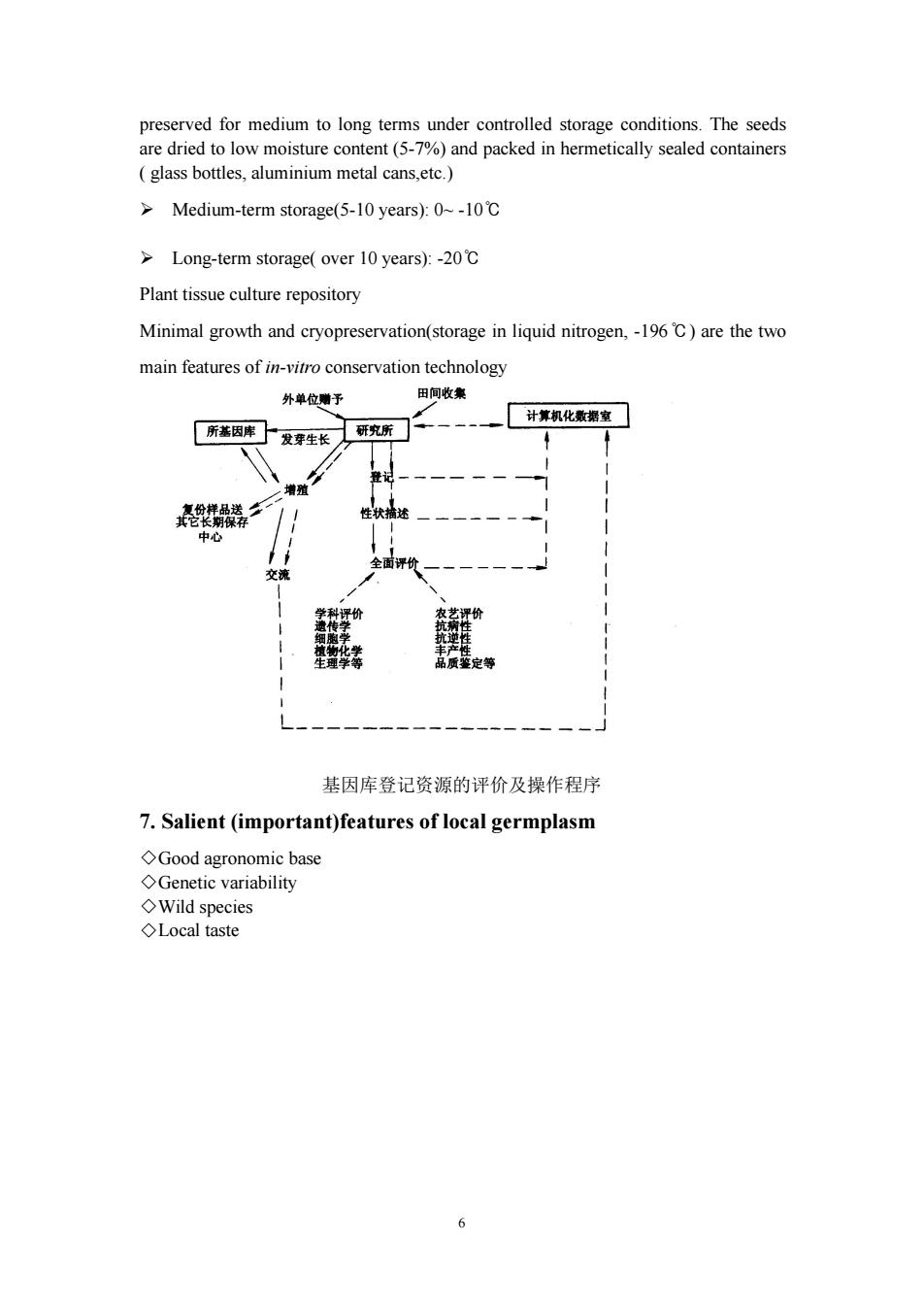
preserved for medium to long terms under controlled storage conditions.The seeds are dried to low moisture content(5-7%)and packed in hermetically sealed containers glass bottles,aluminium metal cans,etc.) Medium-term storage(5-10 years):0~-10C >Long-term storage(over 10 years):-20C Plant tissue culture repository Minimal growth and cryopreservation(storage in liquid nitrogen,-196C)are the two main features of in-vitro conservation technology 外单位赠予 田间收集 计算机化数据室 所基因库 厂发芽生长 研究所 增殖 中心 交流 农艺评价 品质 定等 基因库登记资源的评价及操作程序 7.Salient (important)features of local germplasm ◇Good agronomic base ◇Genetic variability ◇Wild species ◇Local taste
6 preserved for medium to long terms under controlled storage conditions. The seeds are dried to low moisture content (5-7%) and packed in hermetically sealed containers ( glass bottles, aluminium metal cans,etc.) Medium-term storage(5-10 years): 0~ -10℃ Long-term storage( over 10 years): -20℃ Plant tissue culture repository Minimal growth and cryopreservation(storage in liquid nitrogen, -196℃) are the two main features of in-vitro conservation technology 基因库登记资源的评价及操作程序 7. Salient (important)features of local germplasm ◇Good agronomic base ◇Genetic variability ◇Wild species ◇Local taste

Chapter 3 Reproductive System A good insight into reproductive systems of crop species is necessary for a plant breeder for the following reasons. Plant breeding methodology differs for the most part according to the system of reproduction of a crop species.To determine the most appropriate methodology for a crop species precise knowledge of its reproductive system is therefore essential. A plant breeder is required to make artificial hybridization for genetic studies to elicit information regarding inheritance of specific traits and interspecies relationships and for transferring desired characters from one breeding material to another.Precise knowledge of floral structure,floral biology,sex expression,mode of natural pollination and extent of natural outcrossing,etc.for the crop species with which a plant breeder is working is thus essential. Precise knowledge of reproductive behavior is also needed to control pollination to avoid unwanted hybrids (outcrosses)both in breeding nurseries and in pure seed production for commercial purposes,and in the development of hybrid varieties and hybrid seed production. The possible range of reproductive systems in crop species is rather large.The reproductive systems of interest to a plant breeder are discussed below. 1.Sexual Reproduction The normal sexual life cycle of a plant is shown in Fig.4.1. Sporophyte-meiosis-Spore-Gametophyte-fertilization-Zygote-Seed with embryo 1)Autogamy (Self-pollinated,Self-fertilized Crop Species) Crop species in which the pollen of a flower usually pollinates the stigma of the same flower are grouped as self-pollinated crops.The extent of self-pollination varies in different crop species.The following sex expressions favour self-pollination. a))Cleistogamy Refer to the condition wherein pollination takes place in unopened flowers,thus ensuring total self-pollination. b)Chasmogamy Refer to the condition wherein the flower opens only after pollination has taken place.Since the flower opens some outcrossing may take place,though the extent is usually very low. c)Floral Structure In many species,although pollination usually takes place after the flower opens, self-pollination is ensured by the floral structure.The following floral structures favour self-pollination: 1)Stigma may be closely surrounded by anthers,e.g.tomato,eggplant 2)Stamens and stigma are hidden by other floral organs,e.g.legumes. 3)Stigma becomes receptive and elongates through the staminal column,which ensures predominant self-pollination. As a rule,when the extent of natural cross-pollination in a crop species is less
7 Chapter 3 Reproductive System A good insight into reproductive systems of crop species is necessary for a plant breeder for the following reasons. ◇Plant breeding methodology differs for the most part according to the system of reproduction of a crop species. To determine the most appropriate methodology for a crop species precise knowledge of its reproductive system is therefore essential. ◇A plant breeder is required to make artificial hybridization for genetic studies to elicit information regarding inheritance of specific traits and interspecies relationships and for transferring desired characters from one breeding material to another. Precise knowledge of floral structure, floral biology, sex expression, mode of natural pollination and extent of natural outcrossing, etc. for the crop species with which a plant breeder is working is thus essential. ◇Precise knowledge of reproductive behavior is also needed to control pollination to avoid unwanted hybrids (outcrosses) both in breeding nurseries and in pure seed production for commercial purposes, and in the development of hybrid varieties and hybrid seed production. The possible range of reproductive systems in crop species is rather large. The reproductive systems of interest to a plant breeder are discussed below. 1. Sexual Reproduction The normal sexual life cycle of a plant is shown in Fig.4.1. Sporophyte—meiosis—Spore—Gametophyte—fertilization—Zygote—Seed with embryo 1) Autogamy (Self-pollinated, Self-fertilized Crop Species) Crop species in which the pollen of a flower usually pollinates the stigma of the same flower are grouped as self-pollinated crops. The extent of self-pollination varies in different crop species. The following sex expressions favour self-pollination. a) Cleistogamy Refer to the condition wherein pollination takes place in unopened flowers, thus ensuring total self-pollination. b) Chasmogamy Refer to the condition wherein the flower opens only after pollination has taken place. Since the flower opens some outcrossing may take place,though the extent is usually very low. c) Floral Structure In many species, although pollination usually takes place after the flower opens, self-pollination is ensured by the floral structure. The following floral structures favour self-pollination: 1) Stigma may be closely surrounded by anthers,e.g. tomato, eggplant. 2)Stamens and stigma are hidden by other floral organs,e.g. legumes. 3)Stigma becomes receptive and elongates through the staminal column, which ensures predominant self-pollination. As a rule, when the extent of natural cross-pollination in a crop species is less
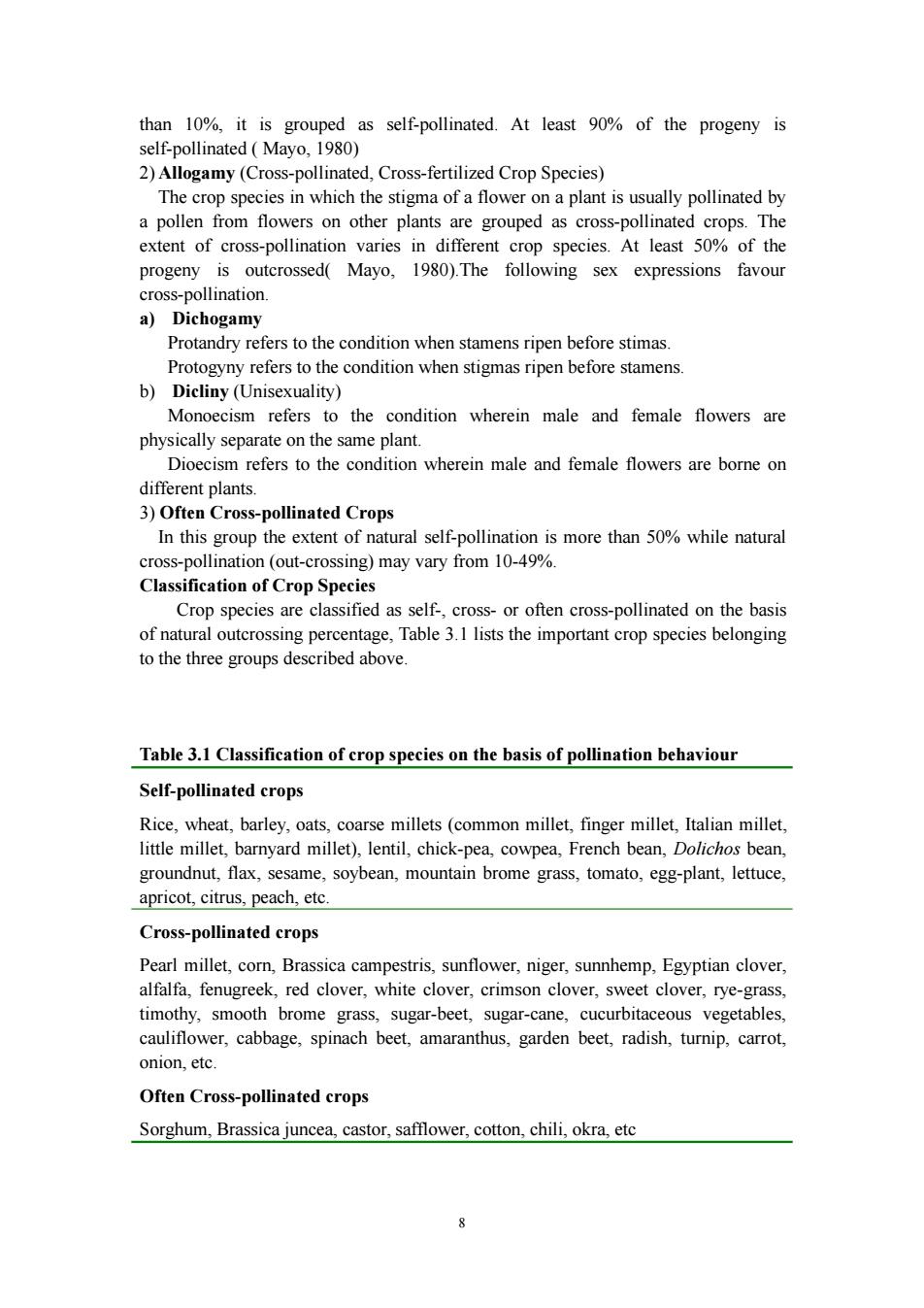
than 10%,it is grouped as self-pollinated.At least 90%of the progeny is self-pollinated(Mayo,1980) 2)Allogamy(Cross-pollinated,Cross-fertilized Crop Species) The crop species in which the stigma of a flower on a plant is usually pollinated by a pollen from flowers on other plants are grouped as cross-pollinated crops.The extent of cross-pollination varies in different crop species.At least 50%of the progeny is outcrossed(Mayo,1980).The following sex expressions favour cross-pollination. a)Dichogamy Protandry refers to the condition when stamens ripen before stimas. Protogyny refers to the condition when stigmas ripen before stamens. b)Dicliny (Unisexuality) Monoecism refers to the condition wherein male and female flowers are physically separate on the same plant. Dioecism refers to the condition wherein male and female flowers are borne on different plants. 3)Often Cross-pollinated Crops In this group the extent of natural self-pollination is more than 50%while natural cross-pollination (out-crossing)may vary from 10-49%. Classification of Crop Species Crop species are classified as self-,cross-or often cross-pollinated on the basis of natural outcrossing percentage,Table 3.1 lists the important crop species belonging to the three groups described above. Table 3.1 Classification of crop species on the basis of pollination behaviour Self-pollinated crops Rice,wheat,barley,oats,coarse millets (common millet,finger millet,Italian millet, little millet,barnyard millet),lentil,chick-pea,cowpea,French bean,Dolichos bean, groundnut,flax,sesame,soybean,mountain brome grass,tomato,egg-plant,lettuce, apricot,citrus,peach,etc. Cross-pollinated crops Pearl millet,corn,Brassica campestris,sunflower,niger,sunnhemp,Egyptian clover, alfalfa,fenugreek,red clover,white clover,crimson clover,sweet clover,rye-grass, timothy,smooth brome grass,sugar-beet,sugar-cane,cucurbitaceous vegetables, cauliflower,cabbage,spinach beet,amaranthus,garden beet,radish,turnip,carrot, onion,etc. Often Cross-pollinated crops Sorghum,Brassica juncea,castor,safflower,cotton,chili,okra,etc
8 than 10%, it is grouped as self-pollinated. At least 90% of the progeny is self-pollinated ( Mayo, 1980) 2) Allogamy (Cross-pollinated, Cross-fertilized Crop Species) The crop species in which the stigma of a flower on a plant is usually pollinated by a pollen from flowers on other plants are grouped as cross-pollinated crops. The extent of cross-pollination varies in different crop species. At least 50% of the progeny is outcrossed( Mayo, 1980).The following sex expressions favour cross-pollination. a) Dichogamy Protandry refers to the condition when stamens ripen before stimas. Protogyny refers to the condition when stigmas ripen before stamens. b) Dicliny (Unisexuality) Monoecism refers to the condition wherein male and female flowers are physically separate on the same plant. Dioecism refers to the condition wherein male and female flowers are borne on different plants. 3) Often Cross-pollinated Crops In this group the extent of natural self-pollination is more than 50% while natural cross-pollination (out-crossing) may vary from 10-49%. Classification of Crop Species Crop species are classified as self-, cross- or often cross-pollinated on the basis of natural outcrossing percentage, Table 3.1 lists the important crop species belonging to the three groups described above. Table 3.1 Classification of crop species on the basis of pollination behaviour Self-pollinated crops Rice, wheat, barley, oats, coarse millets (common millet, finger millet, Italian millet, little millet, barnyard millet), lentil, chick-pea, cowpea, French bean, Dolichos bean, groundnut, flax, sesame, soybean, mountain brome grass, tomato, egg-plant, lettuce, apricot, citrus, peach, etc. Cross-pollinated crops Pearl millet, corn, Brassica campestris, sunflower, niger, sunnhemp, Egyptian clover, alfalfa, fenugreek, red clover, white clover, crimson clover, sweet clover, rye-grass, timothy, smooth brome grass, sugar-beet, sugar-cane, cucurbitaceous vegetables, cauliflower, cabbage, spinach beet, amaranthus, garden beet, radish, turnip, carrot, onion, etc. Often Cross-pollinated crops Sorghum, Brassica juncea, castor, safflower, cotton, chili, okra, etc

Determination of Model of Sexual Reproduction The mode of sexual reproduction,i.e.,whether a crop is self-pollinated or cross-pollinated is reasonably well known for agricultural species.However,if it is not known in respect of a new crop species it can be easily determined.The various steps involved in determination are: 1)Examination of floral structure:The presence of unisexual flowers,dichogamy or other mechanisms(conditions)would indicate the likelihood of cross-pollination. 2)Seedset in isolated single plants:Grow single plants in isolation and observe whether seeds are produced or not. a)If no seed are produced,this is a certain indication that the crop species in question is cross-pollinated. b)If seeds are produced,then it is necessary to grow the selfed seed.Self-pollinated crops do not show inbreeding depression or adverse effects.On the contrary,in cross-pollinated crops the adverse effect of inbreeding is noticeable to varying degrees. 3)Extent of natural outcrossing:This is determined by interplanting with strains carrying a recessive marker gene.Seeda are harvested from the recessive type and the amount of natural outcrossing is calculated from the proportion of recessive and dominant progeny. 2.Asexual Reproduction Asexual reproduction means reproduction through vegetative parts of the plant,such as,buds(roses),bulbs(tulips),tubers(potato),stems(sugar-cane),or other parts,that are utilized to produce new individuals.In addition to these,there are types of asexual reproduction induced under the term apomixes which we shall detail below. Apomixis Apomixes is the substitution of a sexual process with an asexual process.All forms of asexual reproduction in higher plants that replace or act as substitutes for sexual reproduction are known as apomixes. Types of Apomixis 1.Agamospermy In this type of apomixes sexual organs or related parts take part but the seeds are formed asexually without the union of male and female gametes.This is due to modification of the normal meiotic and fertilization processes.Agamospermy is divided into three main groups. a)Gametophytic apomixes b)Adventitious embryony(adventive embryony,sporophytic embryony) c)Non-recurrent apomixes 2.Vegetative apomixes 9
9 Determination of Model of Sexual Reproduction The mode of sexual reproduction, i.e., whether a crop is self-pollinated or cross-pollinated is reasonably well known for agricultural species. However, if it is not known in respect of a new crop species it can be easily determined. The various steps involved in determination are: 1) Examination of floral structure: The presence of unisexual flowers, dichogamy or other mechanisms (conditions) would indicate the likelihood of cross-pollination. 2) Seedset in isolated single plants: Grow single plants in isolation and observe whether seeds are produced or not. a) If no seed are produced, this is a certain indication that the crop species in question is cross-pollinated. b) If seeds are produced, then it is necessary to grow the selfed seed. Self-pollinated crops do not show inbreeding depression or adverse effects. On the contrary, in cross-pollinated crops the adverse effect of inbreeding is noticeable to varying degrees. 3) Extent of natural outcrossing: This is determined by interplanting with strains carrying a recessive marker gene. Seeda are harvested from the recessive type and the amount of natural outcrossing is calculated from the proportion of recessive and dominant progeny. 2. Asexual Reproduction Asexual reproduction means reproduction through vegetative parts of the plant, such as, buds(roses), bulbs(tulips),tubers(potato),stems(sugar-cane), or other parts, that are utilized to produce new individuals. In addition to these, there are types of asexual reproduction induced under the term apomixes which we shall detail below. Apomixis Apomixes is the substitution of a sexual process with an asexual process. All forms of asexual reproduction in higher plants that replace or act as substitutes for sexual reproduction are known as apomixes. Types of Apomixis 1. Agamospermy In this type of apomixes sexual organs or related parts take part but the seeds are formed asexually without the union of male and female gametes. This is due to modification of the normal meiotic and fertilization processes. Agamospermy is divided into three main groups. a) Gametophytic apomixes b) Adventitious embryony (adventive embryony, sporophytic embryony) c) Non-recurrent apomixes 2. Vegetative apomixes

Chapter 4 Male Sterility Male sterility,that is,the incapacity of a plant or plants to produce or to release functional pollen may be true sterility,functional male sterility or sterility induced by a chemical gametocide 1)True male sterility:This type of male sterility is either due to unisexual flowers,that is,absence of male sex organs in female flowers,as in dioecious species and monoecious species,or due to pollen sterility because of irregularities in the development of microspores,causing abortion of the pollen grain in bisexual flowers(hermaphrodite species) 2)Functional male sterility:This type of male sterility results from a defect in the dehiscence mechanism of the anther duo to which pollen are not released and thus fail to fertilize,even though they are fertile. 3)Induced male sterility:This type of male sterility results when certain chemicals (gametocides)are used at a particular stage of crop growth in appropriate doses which interfere with the development of male gametophyte leading to aborted anthers. 1.True Male Sterility 1)Dioecious Species In dioecious species(for example asparagus,hemp,spinach,papaya,date palms)male and female flowers or inflorescences are borne on different plants.Sex determination is under the control of one major gene pair,mm female and Mm male. In all such cases,in which specific sex chromosomes have been identified,the female and male plants are designated as xx(female)and xy(male) 2)Monoecious Species In monoecious species,for example corn,male and female flowers or inflorescences are borne on the same plant but at different places.In some crops,for example cucurbits,the male and female flowers develop successively. 3)Pollen Sterility (Pollen Abortion) Pollen sterility,that is,the failure of the stamens to produce viable pollen may be due to chromosomal factors,extrachromosomal hereditary particles(cytoplasm),or could be due to both the cytoplasmic and chromosomal factors(genetic factors). Non-functional or abortive pollens may be formed in varying degree.Three are generally recognized 0
10 Chapter 4 Male Sterility Male sterility, that is, the incapacity of a plant or plants to produce or to release functional pollen may be true sterility,functional male sterility or sterility induced by a chemical gametocide. 1) True male sterility: This type of male sterility is either due to unisexual flowers, that is, absence of male sex organs in female flowers, as in dioecious species and monoecious species, or due to pollen sterility because of irregularities in the development of microspores, causing abortion of the pollen grain in bisexual flowers(hermaphrodite species) 2) Functional male sterility: This type of male sterility results from a defect in the dehiscence mechanism of the anther duo to which pollen are not released and thus fail to fertilize, even though they are fertile. 3) Induced male sterility: This type of male sterility results when certain chemicals (gametocides)are used at a particular stage of crop growth in appropriate doses which interfere with the development of male gametophyte leading to aborted anthers. 1. True Male Sterility 1) Dioecious Species In dioecious species( for example asparagus, hemp, spinach, papaya, date palms)male and female flowers or inflorescences are borne on different plants. Sex determination is under the control of one major gene pair, mm female and Mm male. In all such cases, in which specific sex chromosomes have been identified, the female and male plants are designated as xx(female) and xy(male). 2) Monoecious Species In monoecious species, for example corn, male and female flowers or inflorescences are borne on the same plant but at different places. In some crops, for example cucurbits, the male and female flowers develop successively. 3) Pollen Sterility (Pollen Abortion) Pollen sterility,that is, the failure of the stamens to produce viable pollen may be due to chromosomal factors, extrachromosomal hereditary particles(cytoplasm),or could be due to both the cytoplasmic and chromosomal factors(genetic factors). Non-functional or abortive pollens may be formed in varying degree. Three are generally recognized